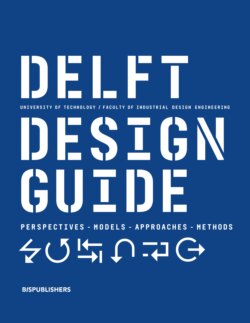Читать книгу Delft Design Guide -Revised edition - Annemiek van Boeijen - Страница 16
На сайте Литреса книга снята с продажи.
ОглавлениеFor this kind of assignment, you can work with the product innovation process to structure the overall process. Methods like SWOT and brand DNA can help to analyse and understand the current situation of the company. Methods like business modelling, and list of requirements to define the design brief and creative problem solving approach to develop and test solutions.
3. Impact fixed, manifestation open.
Assignments like these often have a strong drive to realise change in a specific domain or situation. Hester Le Riche got her PhD in 2017 and developed the so-called Tovertafel (Magic Table). This is a device that creates ‘moments of happiness for people living with dementia and the people around them’. The assignment started with a clear aim to positively impact the lives of people suffering from dementia, yet the manifestation was not determined at that point.
---------
For this kind of assignment, you can work with a user-centred design approach, and use methods like contextmapping and observations as well as research to gain insight into the domain of interest. These insights can be synthesised using, for example, the Persona and Journey Mapping methods. Creativity methods like brainstorming or How-Tos can then be used to develop ideas, and storytelling and experience prototyping for testing and improving concepts.
4. Impact open, manifestation open.
An assignment in this quadrant often aims for exploring future possibilities in a domain, for instance, healthcare or mobility. There is a need to look beyond the current and to create a future vision. A good example is the Redesigning Psychiatry project. This is a consortium of companies and institutions that wanted to improve mental healthcare, with a horizon of 2030. Redesigning Psychiatry envision a future in which mental healthcare is no longer a rigid system but a dynamic network.
---------
For this kind of assignment, you can work with the Vision in Product Design approach to structure the work and explore and define a future direction in terms of impact and solution direction. Then, creativity methods like brainstorming or How-Tos can be used to develop ideas, alongside with storytelling and experience prototyping for testing and improving concepts.
The assignment journey
A design assignment will not stay stuck in a quadrant. As your project progresses, you move through the quadrants until you end up in quadrant one. For example, Boyan Slat started his quest with an open attitude, starting in quadrant three. As he progressed, he found out that 1000 rivers bring 80% of the plastic to the ocean. ‘Closing the tap’ - as he calls it - would heavily contribute to a more plastic free ocean. That led to the idea of the Interceptor moving his project into quadrant one. Sometimes an assignment has unclear or even conflicting aims, making it hard for you to determine where it is positioned. It is a good idea to ask questions and figure out with the relevant stakeholders what is really the aim!
Start-ups often ‘float around’ on this canvas. They often start with an insight, an idea or a hunch of how a certain technology can be brought to the market; manifestation rather clear, impact open. Yet, they might progress and find out that their initial idea for a manifestation was not the right one, flipping between quadrants two and three. They move back and forth between exploring user value and business opportunity. Once matured, they scale-up and stay in a single quadrant for a longer period.
15
